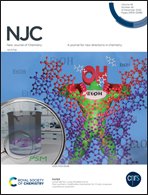Non-aromatic azolo[5,1-c][1,2,4]triazines: a pot, atom and step economic (PASE) synthesis, mechanistic insight and fluorescence properties†
Abstract
A detailed study of the interaction of β-1,2,3-thiadiazolyl enamines with azoles containing diazo function allowed the difference in the reactivity of azole-5-diazonium salts and 5-diazoazoles to be established, which leads to the implementation of various mechanisms of reaction and the formation of aromatic or non-aromatic bicyclic systems. The monitoring of this transformation by NMR spectroscopy revealed the key unstable intermediate which was further isolated under low temperature and thus the evidence for the assigned structures was obtained. An efficient PASE approach to the preparation of new 1,4-dihydropyrazolo[5,1-c][1,2,4]triazines and 1,4-dihydroimidazo[5,1-c][1,2,4]triazines was developed which significantly expanded the scope of these compounds for further studies of their biological activity. The structure and photophysical properties of the synthesized bicyclic heterocycles containing a 1,2,3-thiadiazole ring and several functional groups have been studied. The features of their absorption and emission are revealed, and preliminary directions of their application as new fluorosensors were outlined.
![Graphical abstract: Non-aromatic azolo[5,1-c][1,2,4]triazines: a pot, atom and step economic (PASE) synthesis, mechanistic insight and fluorescence properties](/en/Image/Get?imageInfo.ImageType=GA&imageInfo.ImageIdentifier.ManuscriptID=D2NJ04085A&imageInfo.ImageIdentifier.Year=2022)


 Please wait while we load your content...
Please wait while we load your content...